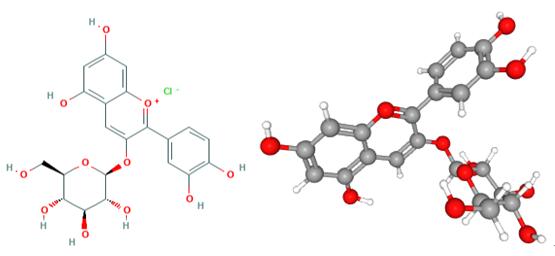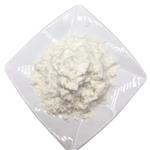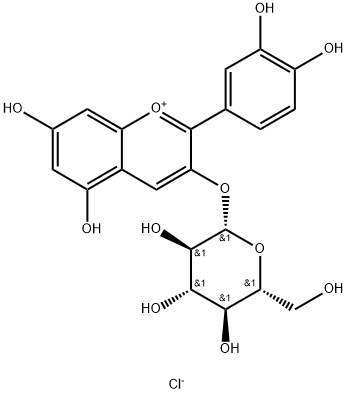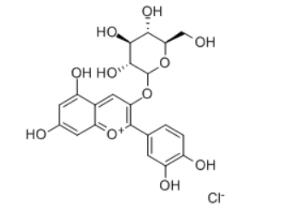Kuromanin Chloride-Application
Kuromanin Chloride is an anthocyanin. Kuromanin Chloride is the 3-glucoside of cyanidin. Kuromanin Chloride can be found in the roselle plant (Hibiscus sabdariffa, Malvaceae), different Japanese angiosperms, Rhaponticum (Asteraceae), The fruits of the smooth arrowwood (Viburnum dentatum, Caprifoliaceae) appear blue. One of the major pigments is cyanidin 3-glucoside, but the total mixture is very complex[1-3].
Kuromanin Chloride has been detected in blackcurrant pomace, in European elderberry, in red raspberries, in soybean seed coats, in victoria plum, in peach, lychee and açaí. Kuromanin Chloride is found in red oranges and black rice[4-7].
Kuromanin Chloride is the major anthocyanin in purple corn (Zea mays). Purple corn is approved in Japan and listed in the "Existing Food Additive List" as purple corn color.
The biosynthesis of cyanidin 3-O-glucoside in Escherichia coli was demonstrated by means of genetic engineering. In Arabidopsis thaliana, a glycosyltransferase, UGT79B1, is involved in the anthocyanin biosynthetic pathway. UGT79B1 protein converts cyanidin 3-O-glucoside to cyanidin 3-O-xylosyl(1→2)glucoside[8-9].

Fig 1. Chemical structure formula and three-dimensional structure of Kuromanin Chloride
Cyanidin-3- O -glucoside exhibits strong antioxidant activities, it has protective effects from blackberry extract against peroxynitrite-induced endothelial dysfunction and vascular failure. Cyanidin-3-O-glucoside chloride decreased mutant p21 expression, and increased the ratio of Bax/Bcl-2 and the activation of caspase-3 to induce apoptosis. Anthocyanins are a group of naturally occurring phenolic compounds as colorants in several plants, flowers and fruits. These pigments have a great importance as quality indicators, as chemotaxonomic markers and antioxidants.
The content of blackberry (Rubus species) juice was investigated by HPLC/ESI/MS using narrow bore HPLC columns. Using this method we demonstrated that cyanidin-3-O-glucoside represents about 80% of the total anthocyanin contents in blackberry extract. Here we investigated antioxidant activity of the blackberry juice and cyanidin-3-O-glucoside on the endothelial dysfunction in cells and in vascular rings exposed to peroxynitrite. In human umbilical vein endothelial cells (HUVEC) in vitro, peroxynitrite caused a significant suppression of mitochondrial respiration (38 +/- 2.1% of control cells), as measured by the mitochondrial-dependent conversion of the dye MTT to formazan. Peroxynitrite caused DNA strand breakage (63 +/- 1.9% single strand vs 3 +/- 0.9% single strand in control cells), as measured by the alkaline unwinding assay, and caused an activation of PARS, as measured by the incorporation of radiolabeled NAD(+) to nuclear proteins. Blackberry juice (different dilutions that contained 80 ppm;40 ppm;14.5 ppm of cyanidin-3-O-glucoside) and cyanidin-3-O-glucoside (as chloride) (0.085 microM; 0.028 microM; 0.0085 microM) reduced the peroxynitrite-induced suppression of mitochondrial respiration, DNA damage and PARS activation in HUVECs. Vascular rings exposed to peroxynitrite exhibited reduced endothelium-dependent relaxant responses in response to acetylcholine as well as a vascular contractility dysfunction in response to norepinephrine. The development of this peroxynitrite-induced vascular dysfunction was ameliorated by the blackberry juice (different dilutions that contained 80 ppm;40 ppm;14.5 ppm of cyanidin-3-O-glucoside) and cyanidin-3-O-glucoside
Sodium pyruvate is utilized as a component in culture broth and media. The use of sodium pyruvate in Wallen fermentation medium to enhance the conversion of oleic acid to 10-ketostearic acid by Bacillus sphaericus has been described. A protocol that uses sodium pyruvate to establish stably transfected human B cell lines has been published.
Three polyphenols were isolated and purified from sugar beet molasses by ultrasonic-aid extraction and various chromatographic techniques, and their structures were elucidated by spectral analysis. Cytotoxicity and the molecular mechanism were measured by methyl thiazolyl tetrazolium (MTT) assay, flow cytometry, caspase-3 activity assay and Western blot assay. The results showed that gallic acid, Cyanidin-3-O-glucoside chloride and epicatechin have cytotoxicity to the human colon, hepatocellular and breast cancer cells. Cyanidin-3-O-glucoside chloride showed its cytotoxicity against various tumor cell lines, particularly against colon cancer Caco-2 cells with half maximal inhibitory concentration (IC50) value of 23.21 ±0.14 μg/mL in vitro. Cyanidin-3-O-glucoside chloride may be a potential candidate for the treatment of colon cancer. In the mechanism study, Cyanidin-3-O-glucoside chloride increased the ratio of cell cycle at G0/G1 phase and reduced cyclin D1 expression on Caco-2 cells. Cyanidin-3-O-glucoside chloride decreased mutant p21 expression, and increased the ratio of Bax/Bcl-2 and the activation of caspase-3 to induce apoptosis.
References
[1] "A survey of anthocyanins in sprouting leaves of some Japanese angiosperms studies on anthocyanins, LXV". Kunijiro Yoshitama, Makiko Ozaku, Michiko Hujii and Kôzô Hayashi, Journal of plant research, Volume 85, Number 4, pages 303–306.
[2] "Chrysanthemin and cyanin in species of the genus Rhaponticum. V. V. Vereskovskii and I. I. Chekalinskaya, Chemistry of natural compounds, Volume 14, Number 4, pages 450–451.
[3] "Food colorants: Anthocyanins". F. J. Francis and Pericles C. Markakis, Critical Reviews in Food Science and Nutrition, 1989, Volume 28, Issue 4, pages 273–314.
[4] Choung, Myoung-Gun; Baek, In-Youl; Kang, Sung-Taeg; Han, Won-Young; Doo-Chull, Shin; Moon, Huhn-Pal; Kang, Kwang-Hee (2001). "Isolation and Determination of Anthocyanins in Seed Coats of Black Soybean (Glycine max (L.) Merr.)". Journal of Agricultural and Food Chemistry. 49 (12): 5848–5851.
[5] Postharvest sensory and phenolic characterization of 'Elegant Lady and 'Carson' peaches. Rodrigo Infante, Loreto Contador, Pía Rubio, Danilo Aros and Álvaro Peña-Neira, Chilean Journal of Agricultural Research, 71(3), July–September 2011, pages 445–451
You may like
Related articles And Qustion
Lastest Price from KUROMANIN CHLORIDE manufacturers

US $999.00-666.00/g2025-04-21
- CAS:
- 7084-24-4
- Min. Order:
- 1g
- Purity:
- 99%
- Supply Ability:
- 5000

US $0.00/mg2023-02-24
- CAS:
- 7084-24-4
- Min. Order:
- 5mg
- Purity:
- ≥98%(HPLC)
- Supply Ability:
- 10 g



